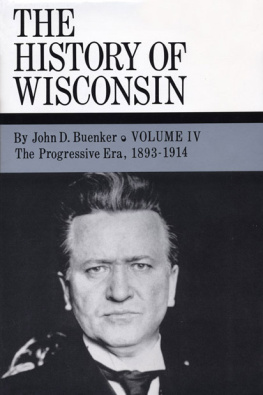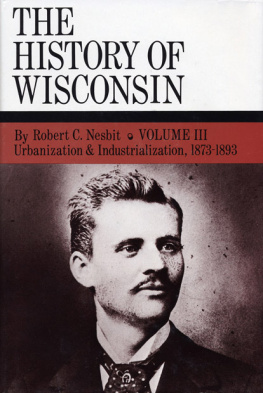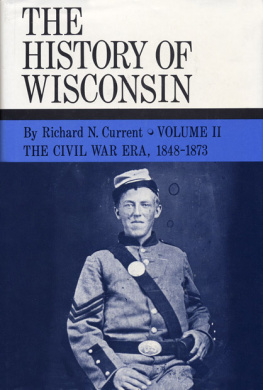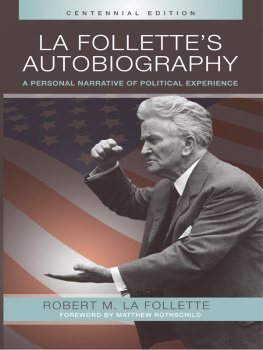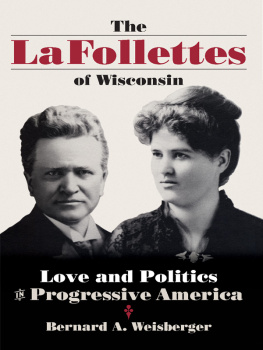THE HISTORY OF
WISCONSIN
THE HISTORY OF WISCONSIN
in six volumes
William Fletcher Thompson
General Editor
VOLUME I:
From Exploration to Statehood
By Alice E. Smith
VOLUME II:
The Civil War Era, 18481873
By Richard N. Current
VOLUME III:
Urbanization & Industrialization, 18731893
By Robert C. Nesbit
VOLUME IV:
The Progressive Era, 18931914
By John D. Buenker
VOLUME V:
War, a New Era, and Depression, 19141940
By Paul W. Glad
VOLUME VI:
Continuity and Change, 19401965
By William F. Thompson
THE HISTORY OF
WISCONSIN
VOLUME IV
The Progressive Era, 18931914
JOHN D. BUENKER
WILLIAM FLETCHER THOMPSON
General Editor
WISCONSIN HISTORICAL SOCIETY PRESS
1998 by the State Historical Society of Wisconsin
E-book edition 2013
For permission to reuse material from The History of Wisconsin, Volume IV: The Progressive Era, 18931914 (ISBN 978-0-87020-303-9, e-book ISBN 978-0-87020-631-3), please access www.copyright.com or contact the Copyright Clearance Center, Inc. (CCC), 222 Rosewood Drive, Danvers, MA 01923, 978-750-8400. CCC is a not-for-profit organization that provides licenses and registration for a variety of users.
www.wisconsin history .org
The Library of Congress has cataloged the printed edition as follows:
(Revised for Volume VI of The History of Wisconsin)
THE HISTORY OF WISCONSIN
Includes bibliography and index.
CONTENTS: v. 1. From exploration to statehood, by Alice E. Smith. v. 2. The Civil War era, 1848-1873, by Richard N. Current. v. 3. Urbanization and industrialization, 1873-1893, by Robert C. Nesbit. v. 4. The Progressive era, 1893-1914, by John D. Buenker. v. 5. War, a new era, and depression, 1914-1940, by Paul W. Glad. v. 6. Continuity and change, 1940-1965, by William F. Thompson.
1. WisconsinHistory.
ISBN 0-87020-303-7
F581.H68 977.5 72-12941
PREFACE
THE YEARS 1893 through 1914 were the most momentous in Wisconsin history, so alive with the promise of constructive change that they are known to history as the Progressive Era.
In less than a quarter-century, the Badger State reconfigured its socio-economic and demographic structure and reconstituted its polity in fundamental and permanent ways. An industrial revolution in dairying transformed Wisconsins agricultural sector into Americas Dairyland, enmeshing the states farmers in a web of developing national commercial and financial systems. The sudden collapse of lumbering and grain milling forced the northwestern three-quarters of the state to reinvent its economic order. The cut-and-run strategy of the lumber barons devastated Wisconsins majestic white pine forests, leaving behind the Cutover region, a quasi-frontier that emerged at the precise moment when Wisconsins historian Frederick Jackson Turner was positing the disappearance of the American frontier. A passionate debate over future use of the Cutover (Farms or forests?) permeated the states public discourse for several decades thereafter.
The southeastern quadrant of the state likewise transformed its industrial base, shifting from one that utilized wind, water, wood, coal, iron, and steam to one that exploited structural steel, vulcanized rubber, reinforced concrete, electricity, and the internal combustion engine. Its economy inexorably emerged as an integral component of the Great Lakes manufacturing belt, characterized by the mass production of durable goods for a national market.
This economic metamorphosis greatly accelerated the development of Wisconsins cities and contributed mightily to the emergence of a new urban form: the industrial city with a radial center. From 1880 to 1910, the states urban population increased four times faster than its rural population. As the primary locus of the New Industrialism, Wisconsins cities formed a symbiotic relationship with their hinterlands, processing their raw materials, eating their foodstuffs, selling them manufactured products, and providing them with many of the amenities of modern life. The explosion of urban populations generated acute housing shortages, crises in public health and education, and alarming increases in crime and vice. Such conditions virtually mandated a massive augmentation in the volume, scope, and variety of municipal services, caused intense political conflict over their generation, financing, and distribution, and inaugurated a panoply of municipal reforms.
As Wisconsinites become more urbanized, they also become more Americanized, at least in terms of birth. Between 1890 and 1920, the percentage of American-born persons jumped from 70 to 83 per cent and that of Wisconsin-born persons from 57 to 71 per cent. Even so, the children of immigrant parents remained the largest single component of Wisconsins population, and ethno-cultural clashes continued to divide the American-born and Wisconsin-born, every bit as much as they did the foreign-born. The acculturation and assimilation of the majority population contrasted sharply with the seemingly exotic character of its small numbers of American Indians and African Americans, and of its teeming multitudes of southern and eastern European immigrants. Most immigrants worked as semi-skilled or unskilled laborers and crowded into working-class neighborhoods abutting the factory districts of industrial cities. There they were disproportionately represented among the victims of industrial accidents and unemployment, low wages and long hours; they were also the occupants of substandard housing, the casualties of epidemics, and the host for a variety of social ills. They simultaneously augmented the forces opposed to enforced acculturation and alarmed those who regarded nativism, sumptuary laws, and various forms of discrimination as the proper response to bewildering change.
Within an amazingly short time, a technological, socio-economic, and demographic metamorphosis radically transformed the nature of work, the work force, and the workplace. The multitudes employed in the burgeoning manufacturing and service sectors soon surpassed the numbers toiling in agriculture, lumbering, and mining. The heavily capitalized, highly bureaucratized corporation, with its thousands of stockholders and employees and millions of dollars in product value, supplanted the family farm, the crossroads cheese factory or creamery, the grain or lumber mill, and the mechanical shop as Wisconsins dominant economic unit. Within its confines, high-speed precision machinery, powered by electricity and internal combustion, displaced tens of thousands of skilled craftsmen and artisans. Machines exponentially expanded the market for laborers with no industrial experience or expertise, opening the doors for throngs of women, southern and eastern European immigrants, and young people from farms and small towns. Mass production and the assembly line de-skilled and fragmented industrial work, revolutionizing the structure and operation of factory and mill. Consciously or unconsciously employing the machinery of the New Industrialism as metaphor and model, businessmen, engineers, technicians, and social scientists developed systems of scientific management to ensure maximum efficiency, productivity, and control of the work force.
At the same time, the advent of electrical transmission, the automobile, electric trolley, telephone, mass-circulation newspapers and magazines, and motion pictures facilitated the assimilation and aggregation of great numbers of people, while drastically compressing time and space. The same logic that enrolled workers in functional, hierarchical systems for the mass production of goods and services mandated the systematic mobilization of a great percentage of the population as consumers. The benefits of mass production and mass consumption trickled down from the most advantaged to the leastnot always equitablyalong fault lines of wealth, income, occupation, education, race, ethnicity, gender, age, and geographical location, in a manner that reinforced, widened, and deepened existing social divisionsand created new ones.

